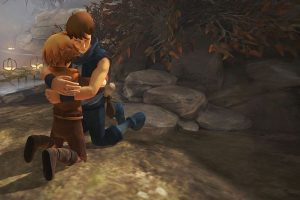
It is not a linguistic accident that the words ‘touching’, ‘feeling’, and ‘moving’ have dual significance. In 1964, psychiatrist Ernst Gellhorn took the etymological link between ‘motion’ and ‘emotion’ as the starting point for his investigation into proprioception. He wondered,
If on receiving news of a great loss one would make up one’s mind to strut back and forth with chest expanded, this posture would interfere with the development of a sad mood appropriate to the occasion.
Gellhorn found that one can induce certain feelings by manipulating one’s physical self. He hypothesised that this is possible because the body is fluent in a somatic language that does not require conscious mediation: strutting, for example, is a gestural expression of confidence that the body intuitively understands. He concluded that when you purposefully manipulates your physical self with the intention of altering your mood, you is engaging in a form of ‘self-communication’ using a somatic language. In 2012, Dr. Amy Cuddy made a similar claim. In her popular TedTalk, she argued that striking a ‘power pose’ not only makes you feel more confident and makes you perform better in stressful situations, it also decreases cortisol levels in the body.
Video games can manipulate a player’s hands by means of the controller; does it follow that video games can communicate with the player via a somatic language? After all, the word ‘controller’ does not clarify who is in control: arguably, the video game has as much control over the player’s movements as the player’s movements have over the video game. The video game can make the player’s hands move rapidly and frantically, or softly and gingerly. It can move her fingers to a steady rhythm or it can stop them moving altogether. Do the pace, rhythm, and type of hand gesture required to play a video game communicate something to the player? Could these gestures ‘interfere with the development of a sad mood’ or, more interestingly, could they stimulate the development of a sad mood?

Brothers: A Tale of Two Sons is a moving text in more senses that one. In fact, the emotional power of this video game is inseparably tied to the hand motions required to play it. In other words, Brothers manipulates a player’s emotions by manipulating her hands. The operational controls of Brothers deviate from what one might term the ‘standard language’ of gameplay gestures. In the majority of adventure games designed for the PlayStation, the left analogue stick moves an avatar around a space while the right analogue stick adjusts the avatar’s ‘viewpoint’. Brothers, however, subverts this operational norm in order to reawaken the player to the significance of the gameplay gestures. Just as some poetry draws attention to the surface of an utterance by violating the norms of ‘everyday’ language, the operational controls in Brothers are obtrusively irregular, and therefore demand that the player considers their full communicative potential.
The game begins in a Nordic, coastal village, streaked with slanting, golden light and populated by pleasant, parochial folk. The young boys embark on a quest to retrieve an elixir from an enchanted tree in a faraway land that will cute their father’s terminal illness. The farther the boys venture from their sleep village, the wilder the world becomes. It is a world abounding in stories of love and death rooted in fairytales, folklore, and legends. In some of these stories the brothers are central agents, as when they reunite a peaceful, mushroomy ogre with his abducted ogress; in others they glimpse only a few frames of the story, as when they stumble upon the silent carnage of a giants’ blood-soaked, abandoned battleground.

Stories happen down side streets, beneath bridges, and atop trees: the more the brothers explore laterally, the more stories they encounter. The wordlessness of Brothers creates ample space for subjective interpretations and imaginative contributions from the player, giving the game not only a sense of emotional authenticity but also a kind of aesthetic polysemy usually associated with literary texts. The visual and auditory signifiers in Brothers are artistically beautiful and semantically rich, but it is the game’s tactile dimension that speaks with stunning eloquence. At the heart of the game is the loving bond between the young brothers. By means of the operational controls, the game manipulates the player’s hands in order to describe the touching relationship between the two boys.
Brothers is best described as a single-player cooperative game, in that the player must control two characters simultaneously. The left hand, via the left stick and left trigger, engages the character of Big Brother. The right hand, via the right stick and right trigger, engages the character of Little Brother. In order to progress through the game, the brothers must work collaboratively, enlisting Big Brother’s strength and Little Brother’s slightness to overcome obstacles and solve puzzles. A mistake with one hand thwarts the efforts of the other, but skillful co-ordination has the brothers protecting, rescuing, and enabling one another.
The unusual two-handed gestural controls of Brothers use both synchronicity and variance to layer moments of gameplay with complex meaning. As metonyms for the two brothers, the player’s hands convey kinship, a unified will, and similitude, while the parallel gestures performed by the player express a sense of instinctive trust and mutual dependency. However, manipulating two avatars at once is not an easy task: one’s hands naturally want to synchronise, but the game requires that they operate independently. This results in moments of frustration – the kind of frustration a young boy may feel at being told ‘he has to stick with Big Brother’, or that ‘he has to let Little Brother tag along’. It would certainly be easier to explore some of the locations using just one avatar, and, on occasion, having to split one’s focus between two avatars evokes a combination of anxiety and resentment that a boy may feel when having to constantly keep an eye on his brother. In short, the gestural challenge of manipulating both siblings captures something of fraternal bonds: fundamental and measureless devotion combined with short-lived annoyance and exasperation. What is more, as the game progresses, the player becomes more adept at managing both avatars, which creates a sense that the bond between the brothers is growing in depth and strength. ‘Squabbles’ become less frequent and the boys seem to intuitively lean on each other as they face an increasingly hostile world.
The poetic potential of this tactile description of the brothers’ relationship is affirmed in the closing chapters of the game. When the siblings finally arrive at the enchanted tree, Big Brother is grievously ill following an encounter with a poisonous human-spider hybrid. Little Brother props Big Brother against the foot of the tree and hurries to fetch the healing elixir from a luminous, blue pool suspended in the tree’s topmost branches. Up until this point in the game, the brothers have been inseparable – the game does not permit one brother to leave the frame without the other brother; but now, for the first time, Little Brother sets off alone and Big Brother disappears from view. By the time Little Brother returns with a flask full of the elixir, Big Brother’s body has curled around his huge chest wound and he has died. A cutscene shows Little Brother desperately trying to pour the elixir down Big Brother’s throat and then howling when he realises that he is too late. At this point, the camera pulls away until the brothers are too small to see.

When the camera returns, some time has passed and Little Brother has dug a grave for Big Brother. The player must direct Little Brother to drag Big Brother’s body into the hole and cover it with earth. Little Brother’s responses to the operational controls are exaggeratedly slow, which serves to convey the character’s emotional exhaustion whilst also forcing the player to complete this harrowing ritual at a solemn pace. If the player does not apply constant pressure to the right analogue stick, Little Brother collapses to the ground, seemingly paralysed by grief. This detail transforms the player’s gestures from ‘directions’ to ‘fortification’: the player feels that she is not merely telling Little Brother what to do, but that she is supporting him in his darkest hour. The auditory and visual signifiers in this sequence connote agony and abjection: the soundscape is silent apart from Little Brother’s half-stifled sobs, and the image of a living child standing in the grave of a dead child seems to proclaim the death of hope, the death of innocence, and the death of childhood. However, running counter to these visual and auditory descriptors are the player’s gestures, which express the remarkable resilience of the spirit – the need and the ability to somehow keep moving in the wake of tragedy.
Josef Fares, the creator of Brothers, has made it known that his own childhood experience of burying the body of a younger brother shaped this moment of gameplay. Retelling a childhood trauma through art creates an opportunity to parent one’s childself – to feel pity and compassion for one’s childself whilst retroactively offering it the comfort and reassurance it was once denied. By participating manually in Big Brother’s burial rites, the player is able to protest against the indifference of Death and the utter loneliness of grief: in spite of the desolate visuals and sounds, the tactile dimension asserts that Little Brother is not truly alone because the player’s presence continues to be ‘felt’ in the storyworld. Whilst Little Brother’s earth-stained hands are offered as virtual extensions of the player’s hands, the player retains a sense of her own distinct identity as she fills the grave, so that the relation between player and avatar is best figured as the player’s unseen, ghostly hands holding Little Brother’s hands, with all the implications of tenderness and commiseration this gesture signifies.
After Big Brother’s death, the lefthand half of the controller seems to ‘die’ too, in the sense that it is no longer possible to interact with the storyworld via the left stick or left trigger. The loss of the player’s left hand is a powerful description of bereavement, and tackling the final challenges one-handed expresses Little’s Brother’s vulnerability and isolation with poignancy and pathos. Little Brother’s loneliness is, in a very literal sense, palpable, in that the game takes away something from the player and instantly the storyworld becomes half as bright and half as broad. In the final sequence of Brothers, Little Brother must swim to the island where his critically ill father awaits him. A storm swells at sea and lightning cracks the night’s sky. Little Brother has a morbid fear of open water that stems from having witnessed his mother drown at sea, and so previously in the game he has clung to Big Brother’s back when the two have had to cross a stretch of water. A short cutscene informs the player that if Little Brother does not reach his father soon, he will lose the opportunity to save the life of the only family member he has left; however, if the player tries to make Little Brother swim to the island, Little Brother refuses to go more than waist-deep into the dark, choppy water. This prompts the player to look for alternative routes to the island but, finding none, the player is eventually forced to return to the water’s edge. In desperation, the player may start randomly pressing buttons on the controller in the hope that one combination will impel Little Brother to swim.
If the player presses the left trigger, which has been redundant since Big Brother’s death, the player will hear the gentle voice of Big Brother whispering soft words of encouragement to Little Brother. The camera zooms closer to Little Brother as if the player had taken a sudden step towards him, and the controller starts to vibrate as if a mute force were urgently trying to communicate. Strengthened by this moment of spiritual intervention, Little Brother finds the courage to plunge into the water and splash frantically and ineptly to the opposite shore.
It is a bittersweet moment of gameplay that invites feelings of pride and relief, mixed with a renewed sense of the enormity of Little Brother’s loss. Little Brother’s journey to the island only achieves its full poetic significance in the moment the gameplay gestures are performed. The sense of urgency and panic is engendered by the player’s rapid and repeated clicking, and the feeling of futility is created by the player’s failed attempts to solve the puzzle. Furthermore, because the game requires the player to explore and experiment – even to the point of despair – before discovering the momentary and surprising ability to invoke Big Brother’s spirit, the unexpected resurrection acquires a miraculous quality and the player’s operational gesture becomes a description of love’s final triumph over death. When experienced in this way, the player’s reanimated left hand seems to temporarily connect the spirit realm and the mortal realm, and to suggest that although Big Brother is no longer manifest in the on- screen storyworld, he lives on in the parallel dimension that is the player’s reality, eternally bound to his Little Brother through the connective tissue of the player. It amounts to a stark and eerie moment of metalepsis: the player has the sensation that narrative levels are collapsing as she seemingly violates the rules of the storyworld in order to reach out to Little Brother, whilst simultaneously the storyworld seemingly spills from the screen to haunt her left hand as if it were Big Brother’s grave site.

The somatic nature of a tactile language values ‘feeling’ over ‘knowing’: it prioritises subjective intuition over objective certainty. By using gesture to describe the brothers’ continuing connection, Brothers gives the player space to ponder the theist, atheist, mythic, or magical nature of their unbreakable bond. In contrast, if the game had given the player careful directions that required exact semantic interpretation in order to complete the puzzle – for example, if text had appeared that read ‘Press L2 to invoke Big Brother’s Ghost’ – the player’s operational gestures would have constituted only a prosaic description of the story-event. Although the semantic content of the gesture is still emotive, it lacks subtlety. It loses the adjectives ‘desperate’, ‘frantic’, ‘hopeless’, ‘sudden’, ‘surprising’, ‘magical’ and the rhythmic crescendo created by the vigorous stabbing of multiple buttons. It acquires a ‘literalness’ – a kind of one-to-one correlation between signifier and signified – at the expense of a ‘literariness’, which is achieved by encouraging the player to independently construct the significance of pressing left trigger – to ‘feel’ its significance, rather than to ‘know’ its significance. What is more, the wordless language of gesture can speak directly to the wordless part of the mind – it can bypass the player’s prefrontal cortex and directly engage the limbic brain. This means the game can stimulate a range of strong emotions, but ultimately defer to the player to describe the experience. The player may alight on the words ‘love’ and ‘loss’ to express the sensations elicited by Brothers, but equally, she may choose not to transcribe the visceral, and instead leave it unfenced and untalkative.
To return to Gellhorn’s example of strutting back and forth to keep grief at bay, Brothers actually induces grief by paralysing one hand and by physically shrinking and crippling the player’s ability to move. The player can, as this essay has, unpick this gestural metaphor; however, she may find the ending of Brothers is a bruise too tender to probe with words.
Posted: